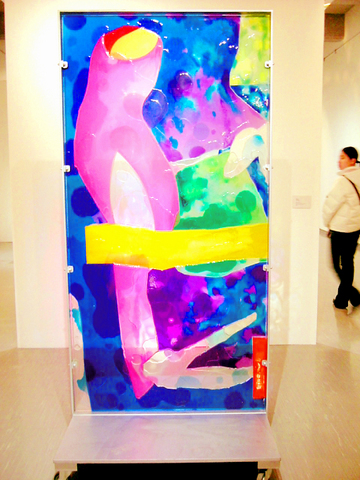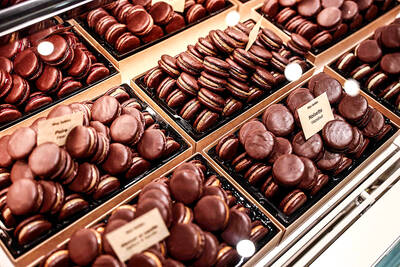Not many local art exhibitions give a behind-the-scenes look at Taiwan's major public art projects. Jun Lai's (
Public art is a recent phenomenon for Taiwan. The percent-for-art program (inspired by Western programs) became law in 1992 and public art came into being six years later. According to recent government statistics, there were 42 public art projects in the year 2001 and 121 projects in 2002.

In 2001, NT$400 million was spent on public art in the city of Taipei alone. As public art projects increase, so do opportunities for Taiwan's artists to gain
visibility.
Public art projects are normally conducted as competitions with either open calls for submissions or selected invitations to submit. The artist then makes a written proposal along with digital imagery of what the finished art project would look like on site.
The proposals are judged by committees, most often by a committee of government officials and then by another committee composed of art experts.
The first-prize winner is funded to create the public art, while the second-prize winner receives money to cover the artist's initial research and proposal costs.
On view at Lai's clearly organized exhibition are examples of Lai's prize-winning public art projects such as South Melody, a set of colorful geometric Plexiglas shapes installed at the Nanshijiao MRT Station. The cheerful lime- green and tomato-red mobiles and glowing azure-blue wall plaques brighten up an otherwise dreary public passageway and bring to mind the pleasing and playful qualities of the work of early modernists such as Miro and Picasso.
In most of Lai's work, the qualities of lightness and translucency are dominant and the durable pieces of shaped plastic -- based on organic forms -- look like glass and so allow the sculptures to interact with the natural light of the environments where they are installed.
The Penghu Mangong Airport project is a perfect example of this interplay of light and color. Lai's fish shapes made from painted Plexiglas are suspended from the ceiling and seem to float in mid-air.
As light from the skylights filters through the terminal, it picks up the dots of blue and green on the fish and allows the bits of color to shimmer onto the floor, thus giving visitors a feel and preview of the island's natural scenery with its breezy winds and sparkling waters.
The huge free-standing multi-colored sculpture placed at the Sihu Service Area of the Second Highway and titled Sihu Concentric brings to mind the corporate-plaza-sized sculptures of Alexander Calder.
Using a modernist vocabulary of shapes and sizes, Lai also incorporates Chinese mythical creatures such as the dragon, phoenix and Chilin (Chinese unicorn). Whimsical and colorful, the sculpture is a joyful sentinel to a dull part of a non-descript flat highway.
Ocean Garden is a glittery, candy-hued collection of shapes to be installed this March at the bland Airport Arrival Hall of Hong Kong's MTRC.
In addition to the public passageways of commuter trains and airport terminals, Lai has also installed work at financial banks often incorporating Chinese principles of Feng Shui design and symbols.
In Friendliness is Conducive to Business Success for the Bank of Taiwan, Lai installed a chandelier-like sculpture that looks like bamboo grown upside-down as that symbolizes fortune and growth. Her intentional placement of light, color and shape was also done to enhance the space's magnetic field to create an area conducive to financial success.
One point that emerges in the exhibition is that in order to be a successful public artist, one must wear many hats: that of businessperson, interior designer, one familiar with architecture, and one who can gauge the public in order to make work that is accessible, non-offensive and consistent.
While working with a limited palette of bright primary and secondary colors, neon lighting and simple organic and geometric shapes, Lai proves to be that type of artist.
Exhibition notes:
What: Jun Lai Public Art Solo Exhibition
Where: Taipei Fine Arts Museum,181, Zhong-Shan North Road, Section 3, Taipei (
Tel: 2595-7656
When: Now through Feb. 13, 2005,Tuesdays to Sundays, 9:30am to 5:30pm. Closed Mondays.
More information: http://www.tfam.gov.tw; www.junjunart.com

Many people noticed the flood of pro-China propaganda across a number of venues in recent weeks that looks like a coordinated assault on US Taiwan policy. It does look like an effort intended to influence the US before the meeting between US President Donald Trump and Chinese dictator Xi Jinping (習近平) over the weekend. Jennifer Kavanagh’s piece in the New York Times in September appears to be the opening strike of the current campaign. She followed up last week in the Lowy Interpreter, blaming the US for causing the PRC to escalate in the Philippines and Taiwan, saying that as

Nov. 3 to Nov. 9 In 1925, 18-year-old Huang Chin-chuan (黃金川) penned the following words: “When will the day of women’s equal rights arrive, so that my talents won’t drift away in the eastern stream?” These were the closing lines to her poem “Female Student” (女學生), which expressed her unwillingness to be confined to traditional female roles and her desire to study and explore the world. Born to a wealthy family on Nov. 5, 1907, Huang was able to study in Japan — a rare privilege for women in her time — and even made a name for herself in the

This year’s Miss Universe in Thailand has been marred by ugly drama, with allegations of an insult to a beauty queen’s intellect, a walkout by pageant contestants and a tearful tantrum by the host. More than 120 women from across the world have gathered in Thailand, vying to be crowned Miss Universe in a contest considered one of the “big four” of global beauty pageants. But the runup has been dominated by the off-stage antics of the coiffed contestants and their Thai hosts, escalating into a feminist firestorm drawing the attention of Mexico’s president. On Tuesday, Mexican delegate Fatima Bosch staged a

Would you eat lab-grown chocolate? I requested a sample from California Cultured, a Sacramento-based company. Its chocolate, not yet commercially available, is made with techniques that have previously been used to synthesize other bioactive products like certain plant-derived pharmaceuticals for commercial sale. A few days later, it arrives. The morsel, barely bigger than a coffee bean, is supposed to be the flavor equivalent of a 70 percent to 80 percent dark chocolate. I tear open its sealed packet and a chocolatey aroma escapes — so far, so good. I pop it in my mouth. Slightly waxy and distinctly bitter, it boasts those bright,